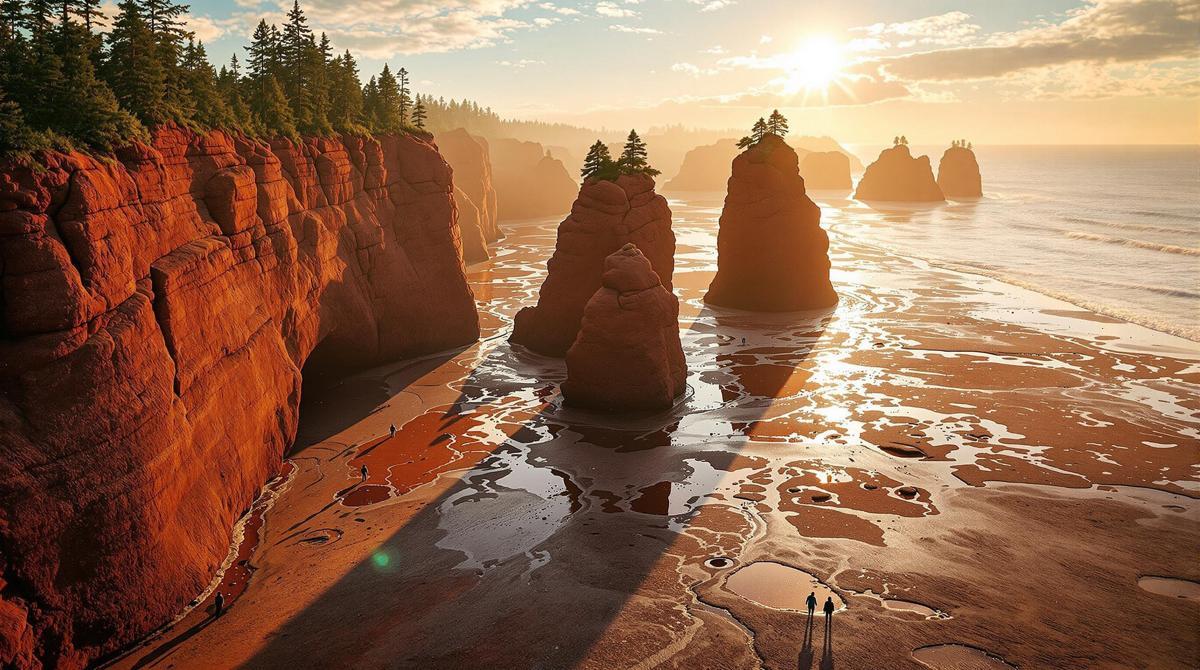The Bay of Fundy hides one of North America’s most dramatic natural wonders – where colossal tides transform the landscape twice daily, revealing a phenomenon that leaves visitors awestruck. Welcome to Hopewell Rocks in New Brunswick, Canada, where the world’s highest tides rise and fall up to 50 feet, creating an otherworldly playground for adventurous travelers.
Walking on the ocean floor: A twice-daily miracle
At low tide, visitors experience the rare thrill of strolling across the ocean floor among towering “flowerpot rocks” – sea stacks carved by centuries of tidal erosion. These majestic formations, standing 40-70 feet tall, resemble giant sculptures with trees perched improbably atop them. Local guide Jamie Peterson explains,
“What makes this place magical is that you can walk where fish were swimming just hours earlier. It’s like visiting two completely different worlds in one day.”
The dramatic transformation: Nature’s ultimate shape-shifter
Six hours later, those same pathways disappear under 50 feet of swirling water, transforming the landscape entirely. The flowerpot rocks become tiny islands in a vast bay. This dramatic cycle, occurring twice daily, creates a destination that demands to be experienced at both extremes. For the full spectacle, many visitors plan two-day stays to witness both conditions.
Whimsical rock formations with personality
Each sea stack has earned a nickname based on its distinctive shape. “Elephant Rock” features a trunk-like protrusion, while “Lover’s Arch” forms a perfect romantic frame for photographs. “Diamond Rock” sparkles when wet, and “ET Rock” bears an uncanny resemblance to the famous extraterrestrial. These natural sculptures change appearance depending on the light, tide, and viewing angle.
Kayaking adventures: Paddle through giants
At high tide, the sea stacks transform into a kayaker’s paradise. Gliding between these towering monuments offers a perspective few ever experience. Local outfitters provide guided tours that time perfectly with the tides. The sunset kayak tours provide especially magical moments when the rocks glow amber in the fading light.
The geological marvel beneath your feet
The rusty-red rocks tell a story 600 million years in the making. Composed of conglomerate and sandstone, these formations contain fossils and sedimentary layers that geologists study with fascination. Dr. Rebecca Morrison, local geologist, notes,
“These rocks are like history books. Each layer represents thousands of years of Earth’s past, compressed into stone.”
Beyond the rocks: Hidden treasures nearby
While Hopewell Rocks steals the spotlight, the surrounding area offers equally compelling attractions. Fundy National Park, just 30 minutes away, features pristine hiking trails through Acadian forest and spectacular coastal views. The lesser-known Cape Enrage lighthouse provides thrilling zipline adventures with panoramic bay views.
Timing is everything: The tidal choreography
Planning your visit requires attention to the tide tables, which shift daily. Park rangers recommend arriving 3 hours before low tide to witness the full transformation. The interpretive center provides real-time updates and educational displays explaining this remarkable natural phenomenon that rivals some of nature’s most spectacular wonders.
Practical considerations for your visit
The park remains open from May through October, with July and August offering the warmest conditions. Bring mud-friendly footwear, as the ocean floor can be slippery. For photographers, the golden hour casts magical light on the formations. Two-day passes allow visitors to experience both tidal extremes, making this a perfect weekend destination for travelers working remotely who can extend their stay.
The Hopewell Rocks phenomenon reminds us that the most extraordinary experiences often operate on nature’s timetable, not ours. Here, twice daily, the ocean withdraws its veil to reveal a hidden world of wonder – only to reclaim it hours later in an endless cycle that has shaped this coastline for millennia. Those who witness this transformation rarely forget the humbling power of nature’s patient artistry.
